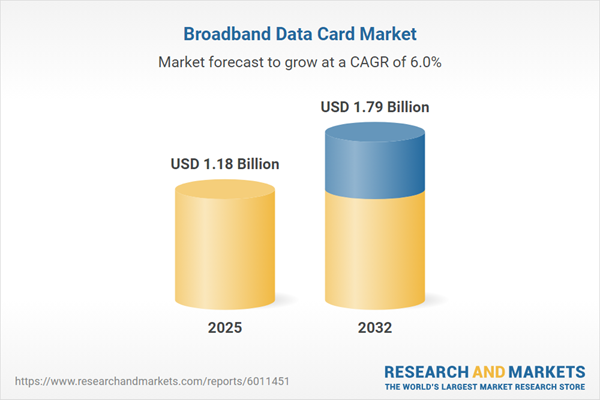Speak directly to the analyst to clarify any post sales queries you may have.
The broadband data card market is central to advancing enterprise wireless connectivity, providing senior decision-makers with agile, scalable solutions that drive adaptation in bustling digital environments. As organizations prioritize seamless operations, broadband data cards emerge as pivotal assets for dependable communication and digital strategy transformation.
Market Snapshot: Broadband Data Card Market Growth and Dynamics
As enterprises invest heavily in digital transformation initiatives, the broadband data card market is demonstrating steady growth supported by continuous enhancements to network infrastructure. Businesses across industries are placing a premium on operational agility by integrating robust wireless connectivity into their long-term IT strategies. With regulatory conditions evolving, providers are enhancing their broadband data card portfolios to incorporate compliance capabilities and performance improvements. Additionally, a heightened demand for sector-tailored connectivity is prompting solution differentiation, which results in higher reliability and improved user satisfaction. These ongoing developments enable organizations to move smoothly between operational models while maintaining trustworthy access to communications networks.Scope & Segmentation: Core Dimensions for Decision-Makers
- Technologies: Broadband data cards deliver compatibility with 2G, 3G, 4G, and 5G networks, making them adaptable for enterprises at various digitalization stages.
- Product Types: The lineup covers express cards, USB models, PCMCIA cards, and portable hotspots, supporting field mobility, smooth device deployment, and simplified management for geographically dispersed teams.
- End Users: Solutions serve professionals, small businesses, medium enterprises, and large organizations by securing high-volume data transfer and supporting compliance across varied workflow scenarios.
- Distribution Channels: Procurement options include offline distributors, direct retail, operator-driven channels, and e-commerce, allowing businesses flexibility and ensuring minimal disruption to operations.
- Plan Types: Offerings encompass both prepaid and postpaid plans, letting organizations synchronize wireless service terms with budgeting cycles and usage patterns.
- Speed Categories: Device segments range from entry-level models under 5 Mbps for essential communication to advanced units exceeding 20 Mbps, supporting demanding applications that require speed and reliability.
- Regional Coverage: The market includes the Americas, EMEA, and Asia-Pacific, with countries such as the United States, China, India, Western Europe, and Japan significantly influencing strategies and regional partnerships.
- Key Companies: Leading industry players include Huawei Technologies, ZTE Corporation, Sierra Wireless, Fibocom Wireless, NETGEAR, TP-Link Technologies, D-Link Corporation, Belkin International, Telit Communications, and Thales S.A.; these firms sustain competitiveness through portfolio enhancement and strategic collaboration.
Key Takeaways: Strategic Insights for Broadband Data Card Market Leaders
- New technologies, notably 5G and edge computing, are changing enterprise connectivity, making it easier to support new digital operating models across distributed locations.
- Improved supply chain flexibility positions organizations to swiftly adjust to regulatory updates and market variability, supporting persistent wireless access and optimized network resilience.
- Wide-scale adoption of modular architectures and compliance-focused solutions allows businesses to deploy reliably across both remote and centralized teams, safeguarding operational integrity.
- Plug-and-play broadband data cards streamline implementation and support expansion of remote work initiatives and automation-enabled processes, expediting deployment cycles.
- Digital procurement platforms are increasing in prominence, granting enterprises greater choice and efficiency when securing wireless connectivity assets.
- Collaboration among device manufacturers, carriers, and service providers is vital to meet performance requirements for complex, multi-site business structures.
Tariff Impact: Navigating New Cost Realities
Recent changes to tariff frameworks are elevating production costs in the broadband data card sector. Organizations are proactively considering local assembly and modular design in their sourcing to mitigate price and supply chain risks. Suppliers are reinforcing their supply networks, increasing compliance visibility, and building wider supplier relationships. These approaches help maintain competitive positioning and safeguard network continuity as market conditions develop.
Methodology & Data Sources
This analysis leverages secondary research, industry expertise, expert consultation, and market analyst contributions. This multi-layered approach ensures reliable, timely guidance to inform procurement and strategic sourcing strategies.
Why This Report Matters: Value for Senior Decision-Makers
- Provides a comprehensive overview of technology trends, procurement models, and supply practices, supporting informed leadership decisions.
- Helps identify profitable investment opportunities by integrating regulatory and market perspectives tailored for executive action.
- Emphasizes the crucial role broadband data cards play in enterprise connectivity and the continuity of operational networks.
Conclusion
Leveraging broadband data card technologies is fundamental to maintaining reliable connectivity and operational adaptability. These solutions empower organizations to remain resilient and responsive as they navigate changing industry dynamics.
Additional Product Information:
- Purchase of this report includes 1 year online access with quarterly updates.
- This report can be updated on request. Please contact our Customer Experience team using the Ask a Question widget on our website.
Table of Contents
3. Executive Summary
4. Market Overview
7. Cumulative Impact of Artificial Intelligence 2025
Companies Mentioned
The companies profiled in this Broadband Data Card market report include:- Huawei Technologies Co., Ltd.
- ZTE Corporation
- Sierra Wireless, Inc.
- Fibocom Wireless Inc.
- NETGEAR, Inc.
- TP-Link Technologies Co., Ltd.
- D-Link Corporation
- Belkin International, Inc.
- Telit Communications PLC
- Thales S.A.
Table Information
| Report Attribute | Details |
|---|---|
| No. of Pages | 180 |
| Published | October 2025 |
| Forecast Period | 2025 - 2032 |
| Estimated Market Value ( USD | $ 1.18 Billion |
| Forecasted Market Value ( USD | $ 1.79 Billion |
| Compound Annual Growth Rate | 6.0% |
| Regions Covered | Global |
| No. of Companies Mentioned | 11 |









